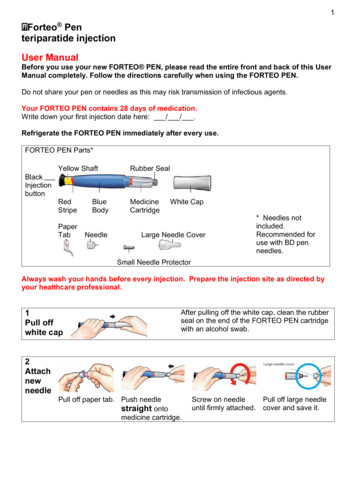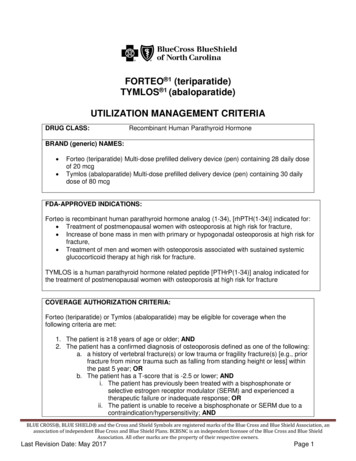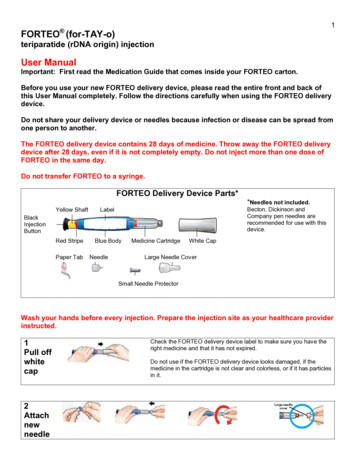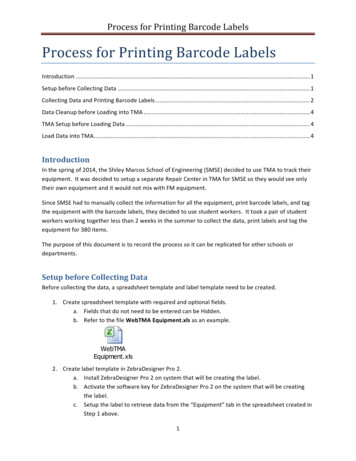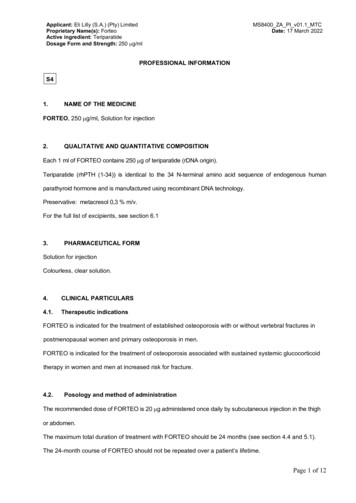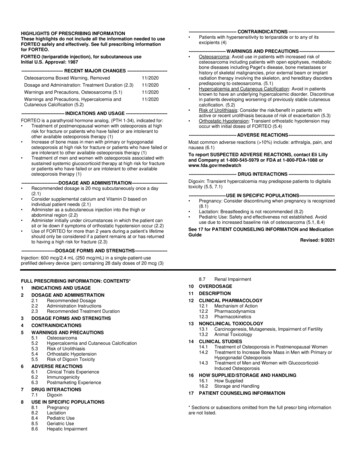
Transcription
HIGHLIGHTS OF PRESCRIBING INFORMATIONThese highlights do not include all the information needed to useFORTEO safely and effectively. See full prescribing informationfor FORTEO.FORTEO (teriparatide injection), for subcutaneous useInitial U.S. Approval: 1987--------------------------- RECENT MAJOR CHANGES -------------------------Osteosarcoma Boxed Warning, Removed11/2020Dosage and Administration: Treatment Duration (2.3)11/2020Warnings and Precautions, Osteosarcoma (5.1)11/2020Warnings and Precautions, Hypercalcemia andCutaneous Calcification (5.2)11/2020---------------------------- INDICATIONS AND USAGE --------------------------FORTEO is a parathyroid hormone analog, (PTH 1-34), indicated for: Treatment of postmenopausal women with osteoporosis at highrisk for fracture or patients who have failed or are intolerant toother available osteoporosis therapy (1) Increase of bone mass in men with primary or hypogonadalosteoporosis at high risk for fracture or patients who have failed orare intolerant to other available osteoporosis therapy (1) Treatment of men and women with osteoporosis associated withsustained systemic glucocorticoid therapy at high risk for fractureor patients who have failed or are intolerant to other availableosteoporosis therapy (1)------------------------DOSAGE AND ADMINISTRATION ---------------------- Recommended dosage is 20 mcg subcutaneously once a day(2.1) Consider supplemental calcium and Vitamin D based onindividual patient needs (2.1) Administer as a subcutaneous injection into the thigh orabdominal region (2.2) Administer initially under circumstances in which the patient cansit or lie down if symptoms of orthostatic hypotension occur (2.2) Use of FORTEO for more than 2 years during a patient’s lifetimeshould only be considered if a patient remains at or has returnedto having a high risk for fracture (2.3)------------------------------- CONTRAINDICATIONS ----------------------------- Patients with hypersensitivity to teriparatide or to any of itsexcipients (4)------------------------ WARNINGS AND PRECAUTIONS ---------------------- Osteosarcoma: Avoid use in patients with increased risk ofosteosarcoma including patients with open epiphyses, metabolicbone diseases including Paget’s disease, bone metastases orhistory of skeletal malignancies, prior external beam or implantradiation therapy involving the skeleton, and hereditary disorderspredisposing to osteosarcoma. (5.1) Hypercalcemia and Cutaneous Calcification: Avoid in patientsknown to have an underlying hypercalcemic disorder. Discontinuein patients developing worsening of previously stable cutaneouscalcification. (5.2) Risk of Urolithiasis: Consider the risk/benefit in patients withactive or recent urolithiasis because of risk of exacerbation (5.3) Orthostatic Hypotension: Transient orthostatic hypotension mayoccur with initial doses of FORTEO (5.4)------------------------------- ADVERSE REACTIONS -----------------------------Most common adverse reactions ( 10%) include: arthralgia, pain, andnausea (6.1)To report SUSPECTED ADVERSE REACTIONS, contact Eli Lillyand Company at 1-800-545-5979 or FDA at 1-800-FDA-1088 --- DRUG INTERACTIONS -----------------------------Digoxin: Transient hypercalcemia may predispose patients to digitalistoxicity (5.5, 7.1)------------------------USE IN SPECIFIC POPULATIONS---------------------- Pregnancy: Consider discontinuing when pregnancy is recognized(8.1) Lactation: Breastfeeding is not recommended (8.2) Pediatric Use: Safety and effectiveness not established. Avoiduse due to increased baseline risk of osteosarcoma (5.1, 8.4)See 17 for PATIENT COUNSELING INFORMATION and MedicationGuideRevised: 9/2021----------------------DOSAGE FORMS AND STRENGTHS--------------------Injection: 600 mcg/2.4 mL (250 mcg/mL) in a single-patient-useprefilled delivery device (pen) containing 28 daily doses of 20 mcg (3)8.7FULL PRESCRIBING INFORMATION: CONTENTS*Renal Impairment1INDICATIONS AND USAGE102DOSAGE AND ADMINISTRATION2.1Recommended Dosage2.2Administration Instructions2.3Recommended Treatment Duration11DESCRIPTION12CLINICAL PHARMACOLOGY12.1 Mechanism of Action12.2 Pharmacodynamics12.3 Pharmacokinetics13NONCLINICAL TOXICOLOGY13.1 Carcinogenesis, Mutagenesis, Impairment of Fertility13.2 Animal Toxicology14ADVERSE REACTIONS6.1Clinical Trials Experience6.2Immunogenicity6.3Postmarketing ExperienceCLINICAL STUDIES14.1 Treatment of Osteoporosis in Postmenopausal Women14.2 Treatment to Increase Bone Mass in Men with Primary orHypogonadal Osteoporosis14.3 Treatment of Men and Women with GlucocorticoidInduced Osteoporosis167DRUG INTERACTIONS7.1DigoxinHOW SUPPLIED/STORAGE AND HANDLING16.1 How Supplied16.2 Storage and Handling17PATIENT COUNSELING INFORMATION8USE IN SPECIFIC POPULATIONS8.1Pregnancy8.2Lactation8.4Pediatric Use8.5Geriatric Use8.6Hepatic Impairment3DOSAGE FORMS AND STRENGTHS4CONTRAINDICATIONS5WARNINGS AND PRECAUTIONS5.1Osteosarcoma5.2Hypercalcemia and Cutaneous Calcification5.3Risk of Urolithiasis5.4Orthostatic Hypotension5.5Risk of Digoxin Toxicity6OVERDOSAGE* Sections or subsections omitted from the full prescr bing informationare not listed.
FULL PRESCRIBING INFORMATION1INDICATIONS AND USAGEFORTEO is indicated: For the treatment of postmenopausal women with osteoporosis at high risk for fracture (defined herein as having ahistory of osteoporotic fracture or multiple risk factors for fracture) or who have failed or are intolerant to other availableosteoporosis therapy. In postmenopausal women with osteoporosis, FORTEO reduces the risk of vertebral andnonvertebral fractures. To increase bone mass in men with primary or hypogonadal osteoporosis at high risk for fracture or who have failed orare intolerant to other available osteoporosis therapy. For the treatment of men and women with osteoporosis associated with sustained systemic glucocorticoid therapy(daily dosage equivalent to 5 mg or greater of prednisone) at high risk for fracture or who have failed or are intolerantto other available osteoporosis therapy.2DOSAGE AND ADMINISTRATION2.1Recommended DosageThe recommended dosage is 20 mcg given subcutaneously once a day. Instruct patients to take supplemental calciumand vitamin D if daily dietary intake is inadequate.2.2Administration Instructions Administer FORTEO as a subcutaneous injection into the thigh or abdominal region. FORTEO is not approved forintravenous or intramuscular use. FORTEO should be administered initially under circumstances in which the patient can sit or lie down if symptoms oforthostatic hypotension occur [see Warnings and Precautions (5.4)]. Parenteral drug products should be inspected visually for particulate matter and discoloration prior to administration(FORTEO is a clear and colorless liquid). Do not use if solid particles appear or if the solution is cloudy or colored. Patients and/or caregivers who administer FORTEO should receive appropriate training and instruction on the properuse of the FORTEO prefilled delivery device (pen) from a qualified health professional.2.3Recommended Treatment DurationUse of FORTEO for more than 2 years during a patient’s lifetime should only be considered if a patient remains at or hasreturned to having a high risk for fracture [see Warnings and Precautions (5.1)].3DOSAGE FORMS AND STRENGTHSInjection: 600 mcg/2.4 mL (250 mcg/mL) clear, colorless solution in a single-patient-use prefilled delivery device (pen)containing 28 daily doses of 20 mcg.4CONTRAINDICATIONSFORTEO is contraindicated in patients with hypersensitivity to teriparatide or to any of its excipients. Hypersensitivityreactions have included angioedema and anaphylaxis [see Adverse Reactions (6.3)].5WARNINGS AND PRECAUTIONS5.1OsteosarcomaAn increase in the incidence of osteosarcoma (a malignant bone tumor) was observed in male and female rats treatedwith teriparatide. Osteosarcoma has been reported in patients treated with FORTEO in the post marketing setting;however, an increased risk of osteosarcoma has not been observed in observational studies in humans. There are limiteddata assessing the risk of osteosarcoma beyond 2 years of FORTEO use [see Dosage and Administration (2.3), AdverseReactions (6.3), and Nonclinical Toxicology (13.1)].Avoid FORTEO use in patients with (these patients are at increased baseline risk of osteosarcoma): Open epiphyses (pediatric and young adult patients) (FORTEO is not approved in pediatric patients) [see Use inSpecific Populations (8.4)]. Metabolic bone diseases other than osteoporosis, including Paget’s disease of the bone.
Bone metastases or a history of skeletal malignancies.Prior external beam or implant radiation therapy involving the skeleton.Hereditary disorders predisposing to osteosarcoma.5.2Hypercalcemia and Cutaneous CalcificationHypercalcemiaFORTEO has not been studied in patients with pre-existing hypercalcemia. FORTEO may cause hypercalcemia and mayexacerbate hypercalcemia in patients with pre-existing hypercalcemia [see Adverse Reactions (6.1, 6.3)]. Avoid FORTEOin patients known to have an underlying hypercalcemic disorder, such as primary hyperparathyroidism.Risk of Cutaneous Calcification Including CalciphylaxisSerious reports of calciphylaxis and worsening of previously stable cutaneous calcification have been reported in the postmarketing setting in patients taking FORTEO. Risk factors for development of calciphylaxis include underlying auto immune disease, kidney failure, and concomitant warfarin or systemic corticosteroid use. Discontinue FORTEO in patientswho develop calciphylaxis or worsening of previously stable cutaneous calcification.5.3Risk of UrolithiasisIn clinical trials, the frequency of urolithiasis was similar in patients treated with FORTEO and patients treated withplacebo. However, FORTEO has not been studied in patients with active urolithiasis. If FORTEO-treated patients havepre-existing hypercalciuria or suspected/known active urolithiasis, consider measuring urinary calcium excretion. Considerthe risks and benefits of use in patients with active or recent urolithiasis because of the potential to exacerbate thiscondition.5.4Orthostatic HypotensionFORTEO should be administered initially under circumstances in which the patient can sit or lie down if symptoms oforthostatic hypotension occur. In short-term clinical pharmacology studies of FORTEO in healthy volunteers, transientepisodes of symptomatic orthostatic hypotension were observed in 5% of volunteers. Typically, these events began within4 hours of dosing and resolved (without treatment) within a few minutes to a few hours. When transient orthostatichypotension occurred, it happened within the first several doses, it was relieved by placing the person in a recliningposition, and it did not preclude continued treatment.5.5Risk of Digoxin ToxicityHypercalcemia may predispose patients to digitalis toxicity because FORTEO transiently increases serum calcium.Consider the potential onset of signs and symptoms of digitalis toxicity when FORTEO is used in patients receivingdigoxin [see Drug Interactions (7.1) and Clinical Pharmacology (12.3)].6ADVERSE REACTIONS6.1Clinical Trials ExperienceBecause clinical studies are conducted under widely varying conditions, adverse reaction rates observed in the clinicalstudies of a drug cannot be directly compared to rates in the clinical studies of another drug and may not reflect the ratesobserved in practice.Men with Primary or Hypogonadal Osteoporosis and Postmenopausal Women with OsteoporosisThe safety of FORTEO in the treatment of osteoporosis in men and postmenopausal women was assessed in tworandomized, double-blind, placebo-controlled trials of 1382 patients (21% men, 79% women) aged 28 to 86 years (mean67 years) [see Clinical Studies (14.1, 14.2)]. The median durations of the trials were 11 months for men and 19 months forwomen, with 691 patients exposed to FORTEO and 691 patients to placebo. All patients received 1000 mg of calciumplus at least 400 IU of vitamin D supplementation per day.The incidence of all-cause mortality was 1% in the FORTEO group and 1% in the placebo group. The incidence of seriousadverse events was 16% in the FORTEO group and 19% in the placebo group. Early discontinuation due to adverseevents occurred in 7% in the FORTEO group and 6% in the placebo group.Table 1 lists adverse events from these two trials that occurred in 2% of FORTEO-treated and more frequently thanplacebo-treated patients.
Table 1: Percentage of Patients with Adverse Events Reported by at Least 2% of FORTEO-Treated Patients and inMore FORTEO-Treated Patients than Placebo-Treated Patients from the Two Principal Osteoporosis Trials inWomen and Men Adverse Events are Shown Without Attribution of CausalityFORTEOPlaceboN 691N 691Event Classification(%)(%)Body as a WholePain21.320.5Headache7.57.4Asthenia8.76.8Neck pain3.02.7CardiovascularHypertension7.16.8Angina pectoris2.51.6Syncope2.61.4Digestive Dyspepsia5.24.1Vomiting3.02.3Gastrointestinal disorder2.32.0Tooth disorder2.01.3MusculoskeletalArthralgia10.18.4Leg cramps2.61.3Nervous 6Vertigo3.82.7Respiratory SystemRhinitis9.68.8Cough onia3.93.3Skin and AppendagesRash4.94.5Sweating2.21.7Laboratory FindingsSerum Calcium — FORTEO transiently increased serum calcium, with the maximal effect observed at approximately 4 to6 hours post-dose. Serum calcium measured at least 16 hours post-dose was not different from pretreatment levels. Inclinical trials, the frequency of at least 1 episode of transient hypercalcemia in the 4 to 6 hours after FORTEOadministration was 11% of women and 6% of men treated with FORTEO compared to 2% of women and 0% of the mentreated with placebo. The percentage of patients treated with FORTEO whose transient hypercalcemia was verified onconsecutive measurements was 3% of women and 1% of men.Urinary Calcium — FORTEO increased urinary calcium excretion, but the frequency of hypercalciuria in clinical trials wassimilar for patients treated with FORTEO and placebo [see Clinical Pharmacology (12.2)].
Serum Uric Acid — FORTEO increased serum uric acid concentrations. In clinical trials, 3% of FORTEO-treated patientshad serum uric acid concentrations above the upper limit of normal compared with 1% of placebo-treated patients.However, the hyperuricemia did not result in an increase in gout, arthralgia, or urolithiasis.Renal Function — No clinically important adverse renal effects were observed in clinical studies. Assessments includedcreatinine clearance; measurements of blood urea nitrogen (BUN), creatinine, and electrolytes in serum; urine specificgravity and pH; and examination of urine sediment.Men and Women with Glucocorticoid-Induced OsteoporosisThe safety of FORTEO in the treatment of men and women with glucocorticoid-induced osteoporosis was assessed in arandomized, double-blind, active-controlled trial of 428 patients (19% men, 81% women) aged 22 to 89 years (mean 57years) treated with 5mg per day prednisone or equivalent for a minimum of 3 months [see Clinical Studies (14.3)]. Theduration of the trial was 18 months with 214 patients exposed to FORTEO and 214 patients exposed to an oral dailybisphosphonate (active control). All patients received 1000 mg of calcium plus 800 IU of vitamin D supplementation perday.There was no increase in mortality in the FORTEO group compared to the active control group. The incidence of seriousadverse events was 21% in FORTEO patients and 18% in active control patients, and included pneumonia (3% FORTEO,1% active control). Early discontinuation because of adverse events occurred in 15% of FORTEO patients and 12% ofactive control patients, and included dizziness (2% FORTEO, 0% active control).Adverse events reported at a higher incidence in the FORTEO group and with at least a 2% difference in FORTEOtreated patients compared with active control-treated patients were: nausea (14%, 7%), gastritis (7%, 3%), pneumonia(6%, 3%), dyspnea (6%, 3%), insomnia (5%, 1%), anxiety (4%, 1%), and herpes zoster (3%, 1%), respectively.6.2ImmunogenicityAs with all peptides, there is potential for immunogenicity. The detection of antibody formation is highly dependent on thesensitivity and specificity of the assay. Additionally, the observed incidence of antibody (including neutralizing antibody)positivity in an assay may be influenced by several factors, including assay methodology, sample handling, timing ofsample collection, concomitant medications, and underlying disease. For these reasons, comparison of the incidence ofantibodies in the studies described below with the incidence of antibodies in other studies or to other teriparatide productsmay be misleading.In the clinical trial of postmenopausal women with osteoporosis [see Clinical Studies (14.1)], antibodies that cross reactedwith teriparatide were detected in 3% of women (15/541) who received FORTEO. Generally, antibodies were firstdetected following 12 months of treatment and diminished after withdrawal of therapy. There was no evidence ofhypersensitivity reactions among these patients. Antibody formation did not appear to have effects on serum calcium, oron bone mineral density (BMD) response.6.3Postmarketing ExperienceAdverse Reactions from Postmarketing Spontaneous ReportsThe following adverse reactions have been identified during postapproval use of FORTEO. Because these reactions arereported voluntarily from a population of uncertain size, it is not always possible to reliably estimate their frequency orestablish a causal relationship to drug exposure. Cases of bone tumor and osteosarcoma have been reported rarely in the postmarketing period [see Warnings andPrecautions (5.2)]. Hypercalcemia greater than 13 mg/dL has been reported with FORTEO use.Adverse events reported since market introduction that were temporally related to FORTEO therapy include the following: Allergic Reactions: Anaphylactic reactions, drug hypersensitivity, angioedema, urticaria Investigations: Hyperuricemia Respiratory System: Acute dyspnea, chest pain Musculoskeletal: Muscle spasms of the leg or back Other: Injection site reactions including injection site pain, swelling and bruising; oro-facial edema
Adverse Reactions from Observational Studies to Assess Incidence of OsteosarcomaTwo osteosarcoma surveillance safety studies (U.S. claims-based database studies) were designed to obtain data on theincidence rate of osteosarcoma among FORTEO-treated patients. In these two studies, three and zero osteosarcomacases were identified among 379,283 and 153,316 FORTEO users, respectively. The study results suggest a similar riskfor osteosarcoma between FORTEO users and their comparators. However, the interpretation of the study results calls forcaution owing to the limitations of the data sources which do not allow for complete measurement and control forconfounders.7DRUG INTERACTIONS7.1DigoxinSporadic case reports have suggested that hypercalcemia may predispose patients to digitalis toxicity. FORTEO maytransiently increase serum calcium. Consider the potential onset of signs and symptoms of digitalis toxicity whenFORTEO is used in patients receiving digoxin [see Warnings and Precaution (5.5) and Clinical Pharmacology (12.3)].8USE IN SPECIFIC POPULATIONS8.1PregnancyRisk SummaryThere are no available data on FORTEO use in pregnant women to evaluate for drug-associated risk of major birthdefects, miscarriage, or adverse maternal or fetal outcomes. Consider discontinuing FORTEO when pregnancy isrecognized.In animal reproduction studies, teriparatide increased skeletal deviations and variations in mouse offspring atsubcutaneous doses equivalent to more than 60 times the recommended 20 mcg human daily dose (based on bodysurface area, mcg/m2), and produced mild growth retardation and reduced motor activity in rat offspring at subcutaneousdoses equivalent to more than 120 times the human dose (see Data).The background risk of major birth defects and miscarriage for the indicated population is unknown. The background riskin the US general population of major birth defects is 2% to 4% and of miscarriage is 15% to 20% of clinically recognizedpregnancies.DataAnimal DataIn animal reproduction studies, pregnant mice received teriparatide during organogenesis at subcutaneous dosesequivalent to 8 to 267 times the human dose (based on body surface area, mcg/m2). At subcutaneous doses 60 timesthe human dose, the fetuses showed an increased incidence of skeletal deviations or variations (interrupted rib, extravertebra or rib). When pregnant rats received teriparatide during organogenesis at subcutaneous doses 16 to 540 timesthe human dose, the fetuses showed no abnormal findings.In a perinatal/postnatal study in pregnant rats dosed subcutaneously from organogenesis through lactation, mild growthretardation was observed in female offspring at doses 120 times the human dose. Mild growth retardation in maleoffspring and reduced motor activity in both male and female offspring were observed at maternal doses of 540 times thehuman dose. There were no developmental or reproductive effects in mice or rats at doses 8 or 16 times the human dose,respectively.8.2LactationRisk SummaryIt is not known whether teriparatide is excreted in human milk, affects human milk production, or has effects on thebreastfed infant. Avoid FORTEO use in women who are breastfeeding.8.4Pediatric UseThe safety and effectiveness of FORTEO have not been established in pediatric patients. Pediatric patients are at higherbaseline risk of osteosarcoma because of open epiphyses [see Warnings and Precautions (5.1)].
8.5Geriatric UseOf the patients who received FORTEO in the osteoporosis trial of 1637 postmenopausal women, 75% were 65 years ofage and older and 23% were 75 years of age and older. Of the patients who received FORTEO in the trial of 437 menwith primary or hypogonadal osteoporosis, 39% were 65 years of age and over and 13% were 75 years of age and over.Of the 214 patients who received FORTEO in the glucocorticoid induced osteoporosis trial, 28% were 65 years of age andolder and 9% were 75 years of age and older. No overall differences in safety or effectiveness of FORTEO have beenobserved between patients 65 years of age and older and younger adult patients.8.6Hepatic ImpairmentNo studies have been performed in patients with hepatic impairment [see Clinical Pharmacology (12.3)].8.7Renal ImpairmentIn 5 patients with severe renal impairment (CrCl 30 mL/minute), the AUC and T1/2 of teriparatide were increased by 73%and 77%, respectively. Maximum serum concentration of teriparatide was not increased. It is unknown whether FORTEOalters the underlying metabolic bone disease seen in chronic renal impairment [see Clinical Pharmacology (12.3)].10OVERDOSAGEIn postmarketing spontaneous reports, there have been cases of medication errors in which the entire contents (up to800 mcg) (40 times the recommended dose) of the FORTEO prefilled delivery device (pen) have been administered as asingle dose. Transient events reported have included nausea, weakness/lethargy and hypotension. No fatalitiesassociated with overdose have been reported. Additional signs, symptoms, and complications of FORTEO overdosagemay include a delayed hypercalcemic effect, vomiting, dizziness, and headache.Overdose Management — There is no specific antidote for a FORTEO overdosage. Treatment of suspected overdosageshould include discontinuation of FORTEO, monitoring of serum calcium and phosphorus, and implementation ofappropriate supportive measures, such as hydration.11DESCRIPTIONFORTEO (teriparatide injection) is a recombinant human parathyroid hormone analog (PTH 1-34). It has an identicalsequence to the 34 N-terminal amino acids (the biologically active region) of the 84-amino acid human parathyroidhormone.The molecular formula of teriparatide is C181H291N55O51S2 and molecular weight is 4117.8 daltons. Its amino acidsequence is shown below:Teriparatide is manufactured using a strain of Escherichia coli modified by recombinant DNA technology.FORTEO is supplied as a sterile, colorless, clear, isotonic solution in a glass cartridge which is pre-assembled into asingle-patient-use delivery device (pen) for subcutaneous injection. Each delivery device (pen) is filled with 2.7 mL todeliver 2.4 mL. Each mL contains 250 mcg of teriparatide (as a free base), 0.41 mg of glacial acetic acid, 0.1 mg ofsodium acetate (anhydrous), 45.4 mg of mannitol, 3 mg of Metacresol, and Water for Injection. In addition, hydrochloricacid solution 10% and/or sodium hydroxide solution 10% may have been added to adjust the pH to 4.
Each prefilled delivery device (pen) delivers 20 mcg of teriparatide per dose for up to 28 days.12CLINICAL PHARMACOLOGY12.1 Mechanism of ActionEndogenous 84-amino acid parathyroid hormone (PTH) is the primary regulator of calcium and phosphate metabolism inbone and kidney. Physiological actions of PTH include regulation of bone metabolism, renal tubular reabsorption ofcalcium and phosphate, and intestinal calcium absorption. The biological actions of PTH and teriparatide are mediatedthrough binding to specific high-affinity cell-surface receptors. Teriparatide and the 34 N-terminal amino acids of PTH bindto these receptors with the same affinity and have the same physiological actions on bone and kidney. Teriparatide is notexpected to accumulate in bone or other tissues.The skeletal effects of teriparatide depend upon the pattern of systemic exposure. Once-daily administration ofteriparatide stimulates new bone formation on trabecular and cortical (periosteal and/or endosteal) bone surfaces bypreferential stimulation of osteoblastic activity over osteoclastic activity. In monkey studies, teriparatide improvedtrabecular microarchitecture and increased bone mass and strength by stimulating new bone formation in both cancellousand cortical bone. In humans, the anabolic effects of teriparatide manifest as an increase in skeletal mass, an increase inmarkers of bone formation and resorption, and an increase in bone strength. By contrast, continuous excess ofendogenous PTH, as occurs in hyperparathyroidism, may be detrimental to the skeleton because bone resorption may bestimulated more than bone formation.12.2 PharmacodynamicsPharmacodynamics in Men with Primary or Hypogonadal Osteoporosis and Postmenopausal Women with OsteoporosisEffects on Mineral Metabolism — Teriparatide affects calcium and phosphorus metabolism in a pattern consistent with theknown actions of endogenous PTH (e.g., increases serum calcium and decreases serum phosphorus).Serum Calcium Concentrations — When teriparatide 20 mcg was administered once daily, the serum calciumconcentration increased transiently, beginning approximately 2 hours after dosing and reaching a maximum concentrationbetween 4 and 6 hours (median increase, 0.4 mg/dL). The serum calcium concentration began to decline approximately6 hours after dosing and returned to baseline by 16 to 24 hours after each dose.In a clinical study of postmenopausal women with osteoporosis, the median peak serum calcium concentration measured4 to 6 hours after dosing with FORTEO (20 mcg subcutaneous once daily) was 9.68 mg/dL at 12 months. The peak serumcalcium remained below 11 mg/dL in 99% of women at each visit. Sustained hypercalcemia was not observed.In this study, 11.1% of women treated with FORTEO had at least 1 serum calcium value above the upper limit of normal(ULN) (10.6 mg/dL) compared with 1.5% of women treated with placebo. The percentage of women treated with FORTEOwhose serum calcium was above the ULN on consecutive 4- to 6-hour post-dose measurements was 3% compared with0.2% of women treated with placebo. In these women, calcium supplements and/or FORTEO doses were reduced. Thetiming of these dose reductions was at the discretion of the investigator. FORTEO dose adjustments were made atvarying intervals after the first observation of increased serum calcium (median 21 weeks). During these intervals, therewas no evidence of progressive increases in serum calcium.In a clinical study of men with either primary or hypogonadal osteoporosis, the effects on serum calcium were similar tothose observed in postmenopausal women. The median peak serum calcium concentration measured 4 to 6 hours afterdosing with FORTEO was 9.44 mg/dL at 12 months. The peak serum calcium remained below 11 mg/dL in 98% of men ateach visit. Sustained hypercalcemia was not observed.In this study, 6% of men treated with FORTEO daily had at least 1 serum calcium value above the ULN (10.6 mg/dL)compared with none of the men treated with placebo. The percentage of men treated with FORTEO whose serum calciumwas above the ULN on consecutive measurements was 1.3% (2 men) compared with none of the men treated withplacebo. Calcium supplementation was reduced in these men [see Warnings and Precautions (5.2) and AdverseReactions (6.1)].In a clinical study of women previously treated for 18 to 39 months with raloxifene (n 26) or alendronate (n 33), meanserum calcium 12 hours after FORTEO treatment was increased by 0.36 to 0.56 mg/dL, after 1 to 6 months of FORTEO
treatment compared with baseline. Of the women pretreated with raloxifene, 3 (11.5%) had a serum calcium 11 mg/dL,and of those pretreated with alendronate, 3 (9.1%) had a serum calcium 11 mg/dL. The highest serum calcium reportedwas 12.5 mg/dL. None of the women had symptoms of hypercalcemia. There were no placebo controls in this study.In the study of patients with glucocorticoid-induced osteoporosis, the effects of FORTEO on serum calcium were similar tothose observed in postmenopausal women with osteoporosis not taking glucocorticoids.Urinary Calcium Excretion — In a clinical study of postmenopausal women with oste
Injection: 600 mcg/2.4 mL (250 mcg/mL) clear, colorless solution in a single-patient-use prefilled delivery device (pen) containing 28 daily doses of 20 mcg. 4 CONTRAINDICATIONS . FORTEO is contraindicated in patients with hypersensitivity to teriparatide or to any of its excipients. Hypersensitivity reactions have included angioedema and .
